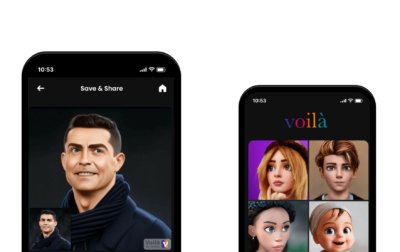Cross-platform vs. native development – What to pick in 2025? (Updated)
01.
Nowadays, the competition in the business landscape is becoming more and more fierce. If companies want to thrive, they now have to be more and more considerate about their digital presence – and the kind of mobile apps they produce.
In 2025, global smartphone adoption is expected to surpass 7.43 billion users, while app revenue will reach $613 billion. At this point, it has become increasingly important to choose the perfect app development model to stand out.
At Touchlane, we have compiled this guide to help you choose between native or cross-platform development as the optimal technology strategy for your project. Below, we will explain the main factors to take into consideration when choosing between these two and describe the essence of each development type, as well as pinpoint their strong and weak sides.
02.
Native vs. cross-platform – How to understand what you need
Before comparing development models, consider less obvious but critical factors that influence technology choices, app design, and the end-user experience. These decisions have long-term implications for performance, scalability, and market reach.
Therefore, it is highly recommended to thoroughly think over the following questions before rushing into the development stage:
- Which mobile platform – Android, iOS, or both – does your target market mostly use?
- Which devices – mobile, web, or both – will the app you create function on?
- What features will your app offer?
- What is your project’s prearranged budget?
- What timeframes do you allocate?
- Do you intend to upgrade or enhance your mobile product in the future?
- What is the focus industry of your endeavor?
Undeniably, you will be in a better position to arrive at conclusions after you have a definitive answer to each of these points. Such analysis will help you define the main goals and weak spots, and the development approach that will affect the whole result. Now, let us uncover all the subtleties and possible benefits of each model.
Dramatic growth
Globally, the mobile app market is experiencing huge growth. Mobile users spent a total of 4.2 trillion hours on apps last year, with consumer spending hitting $150 billion for the first time. This creates an opportunity to attract attention and reach more users.
03.
Native App Development
A native app is built specifically for a mobile platform or operating system, such as iOS or Android. It is created with platform-specific programming languages, instruments, and frameworks. Native applications fully utilize the device’s features to provide maximum adaptability, flexibility for updates, peak performance, and an excellent user experience. These apps make the most of their chosen platform’s capabilities.
In terms of technology stacks, Java or Kotlin is used for Android. In the case of iOS, Swift or Objective-C are the preferred choices. Making use of these languages ascertains a perfect match between the apps and platforms.
Notable real-life examples of native apps
- Google Maps
- Tesla
- Spotify
- Waze.
Pros
- Optimal functionality. Due to their close integration with the hardware and operating system, native apps deliver the greatest efficiency. And the fact that native applications function flawlessly even without internet access is one of its many notable advantages.
- Great UX and UI. Users find native applications intuitive and easy to use because they follow their platform’s design and interface guidelines. Additionally, it is easier to adjust the user interface screen resolution, size, and pixel density, which offers flexibility and convenience for a broader user base.
- Utmost performance. Since native apps are designed specifically for a given platform, they are often responsive and relatively quick. Moreover, they are more efficient since these apps are based on fundamental programming languages and APIs.
- Better scalability. Native apps are also more scalable due to the freedom in resource management and the variety of tools presented. They utilize the full potential of the device.
- Superior security. Since native solutions utilize platform-specific built-in security capabilities, they are also more secure due to complete access to device functions. Therefore, such an approach shows higher levels of security compared to cross-platform apps.
- High speed. Native applications also work quicker than hybrid and cross-platform apps since they lack a complex codebase. As most app components preload in advance, they are presented instantly. If you plan to launch a large project, native development is a 25-30% faster option.
Cons
- Cost and time. Compared to cross-platform and hybrid mobile app development, native development requires more time and expenses, which makes this option less affordable for startups or small businesses. However, if you choose only one platform to code, the effort might be rewarding. In the end, it offers users a smoother experience, positively influencing engagement rates.
- Complicated maintenance. In addition to development costs, it takes twice as much work to upkeep the app across various platforms. Updates, feature additions, and error fixes must be applied individually for every platform, which increases expenses.
Overall, native app development is an excellent choice if you have a complex or long-term project that demands superior quality, extensive customization, and integration with platform-specific features – or in case you need to add device-specific functionalities and create an easy-to-learn app. It should not be confused with the hybrid model. The difference between hybrid and native app development is that the former is platform-agnostic and multi-compatible, whereas the latter is customizable and independent.

04.
Cross-Platform App Development
An average user would want to utilize their favorite application across numerous platforms and devices. Cross-platform app development services can be beneficial in this situation as businesses can use one source code to target various platforms. Thus, instead of developing two native apps, a single codebase can be deployed. The top cross-platform app frameworks nowadays are Flutter, React Native, and Xamarin.
Notable real-life examples of cross-platform apps
- Skype
- Airbnb
- Walmart
- Discord
- Uber Eats.
Pros
- Rapid development. Programmers can create apps for several platforms at once using solely one codebase, which significantly cuts down on development time. For companies looking to swiftly launch their apps, this means quicker time-to-market.
- Code reusability. Developers have no need to write new code for every operating system when creating cross-platform applications. Another advantage is that working with a single codebase simplifies the process of searching for and fixing bugs.
- Development costs. Companies may employ a single mobile development team to reduce expenses rather than allocate budget and people to each platform separately. Also, such an approach implies that the maintenance costs are lower as well.
- Larger market reach. Due to its broad pool of possibilities, cross-platform development is the most successful method of engaging all mobile app consumers, regardless of their platform preference.
Cons
- Performance trade-off. Deploying a single strategy for two systems entails various sacrifices, and limited functionality is one of them. In comparison to native apps, cross-platform apps have lower performance levels since an additional layer of computing is needed.
- Compatibility issues. Not every platform-specific functionality is integrated by cross-platform frameworks. You may run into platform-unique problems or compatibility issues that must be fixed manually for each platform.
- Nowadays this model is prevalent as it ensures a fast and cost-efficient development process and provides the ability to create simple applications. While creating cross-platform software is simple and quick, providing a comparable user experience on the target platform will require more work. The main distinction between cross-platform app vs hybrid app is that the hybrid one consists of native and web solutions.
In 2025, cross-platform development continues to rise in popularity. This approach facilitates a fast and cost-efficient development process and provides the ability to create simple applications. While designing cross-platform software is simple and quick, providing a comparable user experience on the target platform will require more work.
05.
Native vs. cross-platform app development – What should you choose?
As we see above, when releasing a new app, you have two most fitting options – a cross-platform app that covers multiple functions or a native app for each platform. But even after identifying the key characteristics, the right technology may still be unclear. Both approaches seem appealing, but focusing on your main goals will help you decide which one fits best. Depending on your priorities, the choice becomes clearer:
06.
Conclusion
There is no universal solution when choosing between native and cross-platform development. The benefits of cross-platform software development include cost-effectiveness and quicker time to market. However, native app development is stronger in terms of security, hardware incorporation, execution, and customization.
Still, to achieve effective implementation of your app concept, partnering with experts is highly preferable, whether you decide on native or cross-platform app development.
At Touchlane, we always focus on our client’s desires, carefully weigh the pros and cons, account for any potential hazards, and guarantee the best possible value for money. If you would like to discuss which software development approach is better suited for your project with us, contact our experienced mobile team.
This article was first published on May 14, 2024, and updated on April 2, 2025, to include new data.
Tell us about your project
RELATED SERVICES
CUSTOM SOFTWARE DEVELOPMENT
If you have an idea for a product along with put-together business requirements, and you want your time-to-market to be as short as possible without cutting any corners on quality, Touchlane can become your all-in-one technology partner, putting together a cross-functional team and carrying a project all the way to its successful launch into the digital reality.
If you have an idea for a product along with put-together business requirements, and you want your time-to-market to be as short as possible without cutting any corners on quality, Touchlane can become your all-in-one technology partner, putting together a cross-functional team and carrying a project all the way to its successful launch into the digital reality.
We Cover
- Design
- Development
- Testing
- Maintenance












